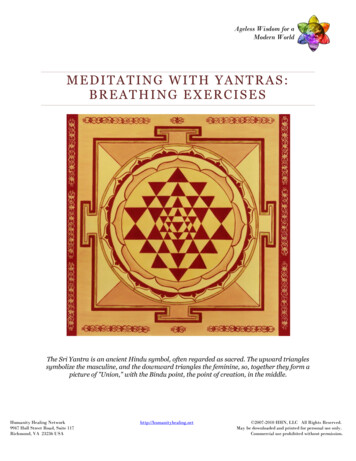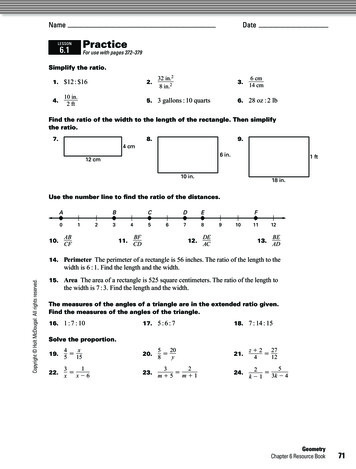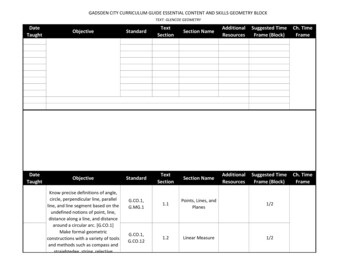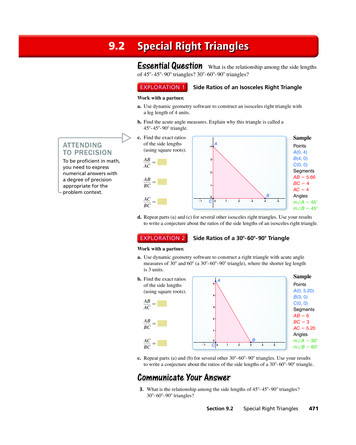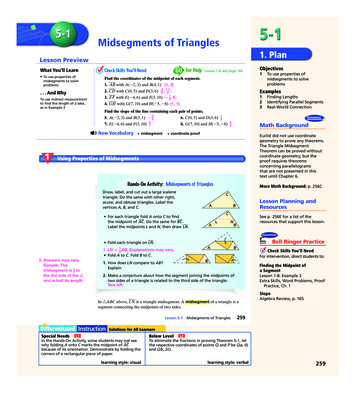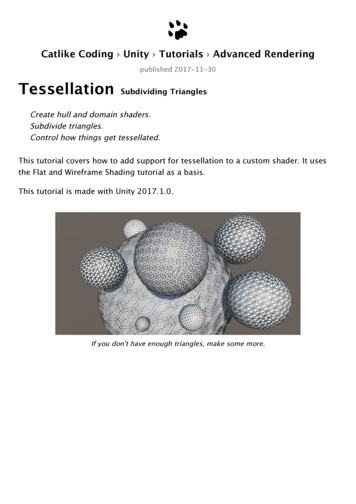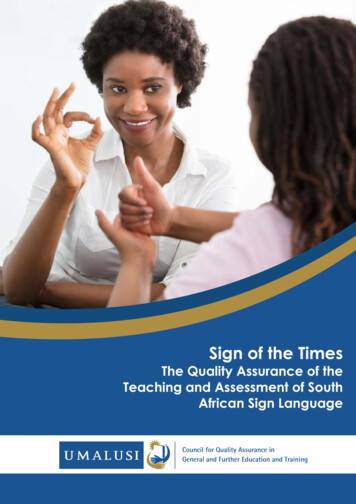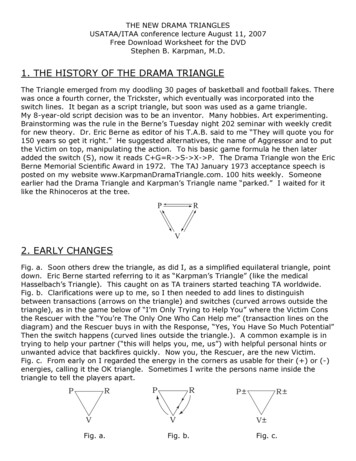
Transcription
THE NEW DRAMA TRIANGLESUSATAA/ITAA conference lecture August 11, 2007Free Download Worksheet for the DVDStephen B. Karpman, M.D.1. THE HISTORY OF THE DRAMA TRIANGLEThe Triangle emerged from my doodling 30 pages of basketball and football fakes. Therewas once a fourth corner, the Trickster, which eventually was incorporated into theswitch lines. It began as a script triangle, but soon was used as a game triangle.My 8-year-old script decision was to be an inventor. Many hobbies. Art experimenting.Brainstorming was the rule in the Berne’s Tuesday night 202 seminar with weekly creditfor new theory. Dr. Eric Berne as editor of his T.A.B. said to me “They will quote you for150 years so get it right.” He suggested alternatives, the name of Aggressor and to putthe Victim on top, manipulating the action. To his basic game formula he then lateradded the switch (S), now it reads C G R- S- X- P. The Drama Triangle won the EricBerne Memorial Scientific Award in 1972. The TAJ January 1973 acceptance speech isposted on my website www.KarpmanDramaTriangle.com. 100 hits weekly. Someoneearlier had the Drama Triangle and Karpman’s Triangle name “parked.” I waited for itlike the Rhinoceros at the tree.2. EARLY CHANGESFig. a. Soon others drew the triangle, as did I, as a simplified equilateral triangle, pointdown. Eric Berne started referring to it as “Karpman’s Triangle” (like the medicalHasselbach’s Triangle). This caught on as TA trainers started teaching TA worldwide.Fig. b. Clarifications were up to me, so I then needed to add lines to distinguishbetween transactions (arrows on the triangle) and switches (curved arrows outside thetriangle), as in the game below of “I’m Only Trying to Help You” where the Victim Consthe Rescuer with the “You’re The Only One Who Can Help me” (transaction lines on thediagram) and the Rescuer buys in with the Response, “Yes, You Have So Much Potential”Then the switch happens (curved lines outside the triangle.). A common example is intrying to help your partner (“this will helps you, me, us”) with helpful personal hints orunwanted advice that backfires quickly. Now you, the Rescuer, are the new Victim.Fig. c. From early on I regarded the energy in the corners as usable for their ( ) or (-)energies, calling it the OK triangle. Sometimes I write the persons name inside thetriangle to tell the players apart.Fig. a.Fig. b.Fig. c.
2OK TRIANGLES. Many others have written up their OK versions. Among others1. Acey Choy published an excellent “Winners Triangle” in the January 1990Transactional Analysis Journal (TAJ) naming the corners Assertive, Caring, andVulnerable, relating it to the Cathexis Institute problem solving model.2. Lewis Quinby on his comprehensive TA website TA-tutor.com borrowed the samePRV initials to read Persevere, Reach-out, and Vulnerable in the Quinby DurableTriangle. I use his Reaching-out word and include my own OK Power and OK Vulnerablecorners to cover the PRV initials.3. David Emerald’s storied quest in his fascinating book “The Power of T.E.D. (TheEmpowerment Dynamic) has the corners relabeled P - Challenger, R - Coach, and V Creator.OTHERS’ CHANGES. Out on the Internet things get changed. Originally I requiredcapital letters to represent game roles so that small letters could represent real roles,i.e. legitimate rescuers, legitimate victims. Didn’t happen. Rarely authors don’t givecredit, some rename the triangle, some draw it “squashed,” etc. Many others(www.LynneForrest.com, etc.) and others have written up thoughtful variations on thetriangle in home and work applications (nursing, teaching, legal, dysfunctional families,entertainment, etc) that turn up in a search of over 15,000 references on Google. TAwriters have shown influences as in the Miniscript Triangle, Redefining Hexagon, andothers. Once in TA a fourth role of the “observer” was added, but if the observer feelsor gains anything, scorekeepers and reporters included, they are in the triangle.Otherwise they are in their Adult.OK TRIANGLES. THE 10% SOLUTION: Into the OK Triangle I soon included ”The 10%solution,” a general rule I find very useful in couples’ therapy, which offers,1) That in every game there are at least 10% OK reasons in each P, R, V corner.2) That every idea spoken has at least 10% truth in it.3) That 10% of the population would react the same way.4) That 10% of what you are saying is not true anyway.The 10% Solution3. DRAMA TRIANGLE VARIATIONSTHE QUESTIONMARK TRIANGLEWhat are the unknown reasons why she dumped him and gave no reasons? Check outsome possibilities, that she felt like the Victim as too hurt or disappointed by him;Rescuer as not being what he needs and doing him a favor by quietly disappearing fromhis life; and Persecutor to get even with him by not giving him a chance to explainhimself. The Triangle offers three motives behind any unexplained action.
3FALSE PERCEPTION TRIANGLESThe diagram above also represents the confusions of false perception in the reading of asituation perhaps as one wants it to be, rather than the way it is. Old familytransferences (“baggage”) or projections of one’s own mind set can alter one’s P, R, andV perception as well. Illustrated below is how some people can get locked intoperceiving things from one corner of the triangle as their only window to the world.The Persecutor WindowThe Rescuer WindowThe Victim WindowDOUBLE BIND TRIANGLESA partner in a custody battle had a periodic substance abuse problem. If he voluntarily(R) admitted he had the problem, it would be used against him in court, and he’d lose.If he lied (P) and denied any problem, they would say he was in denial, and he’d lose.He was in a double bind. Either way, he would lose. The third point (V) of a classicdouble bind is that there is no way of talking about it.THE INDECISION TRIANGLESFig. a. A man wanted to ask his wife for plastic surgery to help with their sex life,hoping she’d be a Rescuer of the relationship. But he knew if he did ask, she wouldreact as Persecutor and push him further away. So he stayed undecided, “stuffingfeelings” as a Victim. In Fig. b., he is harboring grudges as a Victim, but if he speaksout, it will sound too angry (Persecutor), so he stays Victim, undecided. In Fig. c., hefeels neglected and wants to Rescue himself by finding an outside girlfriend, but thatcould backfire and both women would leave him (double Persecutor), and he’d be aVictim again. Double binds are resolved by careful and caring communication over time.If someone is at fault, they should play their ABC cards: Admit It, Believe It, Change It.Fig. aFig. bFig. c
4THE VICIOUS CYCLE TRIANGLESFig. a. Lonely Victims with an Impulse Control Disorder and unmet needs, Rescuethemselves with their food, gambling, sex, power, spending or substance addictions,then suffers repercussions (P) from within or without, returning to Victim again.Fig. b. in the classic Cycle of Violence, the arrow now swings counterclockwise. Therelease from the unappreciated Victim role (#1) is through a tension build up (#2) andthen to violence as Persecutor (#3), then remorse and regrets in the “Hearts andFlowers” apology and promises stage (#4), to start the cycle all over again (at #1).Fig. a.The Addiction TrianglesFig. b.The Cycle of Violence TriangleTRAPPING TRIANGLES and “Betrayal Bonds”In the first two diagrams below, one parent locks out the other parent, either by “Ourspecial secret” bonding or by threat bonding. In the third diagram, the top two roles areso thoroughly controlled and well performed, that the Victim cannot compete and staystrapped in a dependent position.“Don’t tell our special secret”“Don’t tell or else!!!““You can’t get along without me”ESCAPE TRIANGLES“How do I get out of the triangle?” One place to start is with knowledge of the roles andswitches, knowledge of how and why you got there, and knowledge of theconsequences. As games escalate to 1st, 2nd, or 3rd levels, 1) the number of playersincrease, 2) the geography covered widens, 3) the confusion and complexity increases,and 4) the stakes increase to the level of “dire consequences.” Additional reading ofbooks on co-dependency and 12 step meetings are informative and supportive ofchange. Avoid slippery places, slippery people, and slippery thinking. Change your
friends when you get free. With knowledge, when one then senses an invitation to anew drama beginning, they can say “no” to drama.5If one is inside the triangle and aware of the roles and switches and consequences, anescape is available from any corner, as shown below. An escape from each corner:P “I’d rather be mad than sad”R “I’d rather be smarter than martyr”V “I’d rather be getting than fretting”TRIANGLES OF OPPRESSION AND TRIANGLES OF LIBERATIONFig. a. shows social Victims of scarcity and oppression. Attempts to Rescue and freethemselves fail from ineffectiveness, or from putdowns by the usual Persecutors. Thereturn then swings back counterclockwise to Victim again, to start over or to give up.Fig. b. shows OK Rescues by personal determination, or by inspirational heroes, or bysocial movements. The successful OK Persecutor confrontations by leadership or bypersonal assertiveness moves them out of the Triangle, now with all 3 corners satisfied.Fig. a. Get StuckFig. b. Get OutSWITCHING IN THE TRIANGLEThe drama in the Triangle comes from the switching of roles. A game player will beadept at switching roles quickly to avoid any clarity. To defend, deny, and protect theirvice, they quickly switch around, using the Three Rules of Chaos:1) Make a game out of everything,2) Deny everything, and3) Immediately put you on the defensive. (The family rule was “Talk fast, don’t listen”).An alcoholic may show penitence as a remorseful Victim, then switch to a threatening,embarrassing, or guilt-inducing Persecutor; then switch to the Rescuer role and be “toogood to be true” and promise that everything will be better if given a second chance.But soon the sorrowful Victim will return to start the cycle all over again (Fig. a).Fig. a. Evasive switching
6THE ALCOHOLIC FAMILY ROLES line up as:Three family roles:AlcoholicCo-DependentA.C.A. (Adult Child of an Alcoholic)The four classic A.C.A. script choices:“Scapegoat”“Hero,” “Mascot”“Lost Child”4. THE COMPASSION TRIANGLEThe Compassion Triangle is drawn with a sign in the center of the triangle. It offersthe theory that once someone is in the Drama Triangle they will automatically be in allthree roles at once, either in socially identified roles, or as denied roles, overtly andcovertly. Hidden motives can be conscious, subconscious, or as “unintendedconsequences.” All three need to be considered to get a three dimensional view ofgames.Fig. a. The angry boss, as Identified Persecutor, is scolding and embarrassing thesecretary. But secretly the boss is the Victim of the secretary’s careless work, and ofhis/her own job insecurity based on office production; and is also secretly a Rescuer inattempts to train employees to meet high standards and by openly complaining insteadof secretly firing the secretary.Fig. b. The Identified Rescuer can be a co-dependent in a dysfunctional family, but issecretly a Persecutor by enabling the game, and secretly a Victim who won’t escape.Fig. c. The Identified Victim is the classic “Identified Patient” in the example below, thescapegoat Victim in the dysfunctional family. But as Rescuer, serves as a lightning rodby diverting parental anger and to keep the family together, and as Persecutor, bycontinually making the game more and more difficult to solve.Fig. a. Identified PersecutorFig. b. Identified RescuerFig. c. Identified Victim
7THE LIARS TRIANGLEThe liar loses respect as identified Persecutor but may be secretly protecting others andself as a Rescuer, and as Victim is afraid of fair or unfair repercussions based on manyprevious experiences.THE P.T.S.D. DEFENSIVENESS TRIANGLEA sufferer of PTSD (Post Traumatic Stress Syndrome) from an abusive homeenvironment may instinctively react to all criticism as the Persecutor and Victim, and notthink to offer appreciation for the Rescuers attempts to open up communication, noroffer sympathy for the Victim they created with their stresses. A first step would be tooffer the partner the benefit of the doubt, ask good questions, and use the critiqueconstructively.5. THE INNER DRAMA TRIANGLESWe have an Outer Personality and an Inner Personality during games. We canexperience both, one, or none, with or without perceptual distortions. This inner PRVdiagram can describe 1) inner feelings, 2) inner self-talk (self-transactions), or 3) innergame roles (with self-switching) during games. The outer personality and the innerpersonality may be in harmony or disharmony with each other at the same time during agame. Either one may be dominant at any time. With anger, the outer personality is incharge. With depression, the inner personality is in charge.The Miniscript Triangle Drivers begin with the Victim believing in the Rescue, “I’m OK if,I: Be Perfect, Be Strong, Hurry Up, Try Hard, or Please People.” These can work insideand outside at the Rescue corner, and when fail, inevitably drive a person into theirStopper or Blamer position (P), inside and outside the triangle and then over to the finalDespairer (V) position, and then around again, often within seconds.TWO-LEVEL DRAMA TRIANGLESFig. a. The blank space in the middle of the triangle can visually represent those yetunspoken words during a game (“What’s Unsaid”), words that are ready to make thingsworse (-) or to make things better ( ) when the chance arises.Fig. b. The Social Level and the Psychological Level of games can be pictured by Fig. b.Fig. aFig. b.
8THE WISDOM TRIANGLESThe wise person can know of the 24 outer and inner triangles ( /-) in others and inthemselves and find them when necessary to improve compassion and understanding.GOING INSIDE ONESELF TO DEFEAT REASON. THE MANIPULATORS TRIANGLEA person with a “Don’t Think” injunction when confronted or unwilling to listen, can turnagainst him or herself and create a “feelings only” environment where only they can win.R “Now I’ll beat myself over this”(PUNISHING)R ”It’s everyone else’s fault”(PROTECTING)(PITYING)V “I can never do things right”POSITIVE SELF-TALK INSIDEP self determination, direction, discipline, goals, and strength of characterR self stroking, protective, belief in health and self, gathering OK permissionsV self accepting, open, humble, flexible, receptiveDRAMA OPTIONSOne has the option of selectively stroking the OK inner and outer corners of the triangleto improve relationships and easier communication. One can anticipate the negativecorners in advance to prepare for a discussion, also explaining oneself in the process, “Iknow this may not be the right time for this (to avoid P) but I need to know if.”(my V).
96. THE SCRIPT TRIANGLESThe two tiny inner triangles in Fig. a. below illustrate the games occurring in the “ScriptScene.” There is an outer and inner drama happening during childhood scripting.THE INNER REDECISION TRIANGLE1. V ”How did you feel at the time?” (FEEL),2. R ”What did you believe about the world?” (THINK),3. P “What did you decide?” (ACTION) – 13 “Don’t” injunctions or 5 “Do” Drivers)THE OUTER TRANSFERENCE TRIANGLE. Why does the child accept the scripting?1. V Passivity. Mirroring, imprinting, and attribution; mystified, outnumbered.2. R Support. To be the champions of the parent’s beliefs system.3. P Revenge. For revenge to defeat the parent’s hopes and dreams.On the inside space one can insert the non-verbal memories. Injunctions (P), Drivers(R) and Rackets (V) can fit on the corners. The triangles can be called The RedecisionTriangle, The Transference Triangle, or The Scripting Triangle, depending on the usage.TWO-LEVEL DRAMA TRIANGLESTHREE-LEVEL DRAMA TRIANGLES
SCRIPT THERAPYFig. a. Illustrates the therapists Reparenting (P ) messages being incorporatedFig. b. Illustrates the therapists Permission (R ) messages being incorporatedFig. c. Illustrates the therapists Relational (V ) messages being incorporatedFig. a.Fig. b.10Fig. c.PROGRESSION OF UNMET NEEDSNeeds can be Freudian, Ericksonian, Maslow, Schiff and Levin listed needs. Berne’s 6hungers (Recognition, Contact, Stimulus, Sex, Incidence, and Structure), or it could bethe unmet needs in the Goulding’s 13 Don’t injunctions (including Don’t Want). Theseall can be unmet needs continuing forward through one’s lifetime, as illustrated below.7. BIOCHEMICAL TRIANGLESPlace a smaller triangle inside the Script Triangle for the transactions at the cellularlevel, which would include the animal, racial, and family genetics; and organic andbiochemical transactions with the script decisions. A five level TA “Unified Field Theory”diagram: an outer and inner social level, inner and outer script level, and cellular level.GENETIC DYNAMICS. There can be dominating genes (P), future evolution genes (R) andunsuccessful genes (V).CELL TRANSACTIONS. One set of cells (R) transact to provide the chemicals, hormones,etc. (RESUPPLY) to the awaiting (V) receiving cells (RECEPTION), while the (P) cells(RESTRICTION) inhibit over-production and over-absorption. For example, serotonin isproduced, received, and the excess is cleared. The SSRI antidepressants inhibit theserotonin absorption by receptor cells, thus allowing the serotonin levels to remain high.Copyright 1967, 2007 by Stephen B. Karpman, M.D. All rights reserved. www.KarpmanDramaTriangle.comDownloads free. Many thanks to Eric Karpman for graphics at www.EricsGraphics.com.
6 THE ALCOHOLIC FAMILY ROLES line up as: Three family roles: Alcoholic Co-Dependent A.C.A. (Adult Child of an Alcoholic) The four classic A.C.A. script choices:




